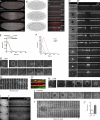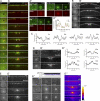Cell wound repair in Drosophila occurs through three distinct phases of membrane and cytoskeletal remodeling
- PMID: 21518790
- PMCID: PMC3087011
- DOI: 10.1083/jcb.201011018
Cell wound repair in Drosophila occurs through three distinct phases of membrane and cytoskeletal remodeling
Abstract
When single cells or tissues are injured, the wound must be repaired quickly in order to prevent cell death, loss of tissue integrity, and invasion by microorganisms. We describe Drosophila as a genetically tractable model to dissect the mechanisms of single-cell wound repair. By analyzing the expression and the effects of perturbations of actin, myosin, microtubules, E-cadherin, and the plasma membrane, we define three distinct phases in the repair process-expansion, contraction, and closure-and identify specific components required during each phase. Specifically, plasma membrane mobilization and assembly of a contractile actomyosin ring are required for this process. In addition, E-cadherin accumulates at the wound edge, and wound expansion is excessive in E-cadherin mutants, suggesting a role for E-cadherin in anchoring the actomyosin ring to the plasma membrane. Our results show that single-cell wound repair requires specific spatial and temporal cytoskeleton responses with distinct components and mechanisms required at different stages of the process.
Figures





References
Publication types
MeSH terms
Substances
Grants and funding
LinkOut - more resources
Full Text Sources
Other Literature Sources
Molecular Biology Databases
Research Materials

